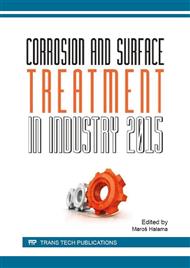p.115
p.125
p.133
p.141
p.146
p.153
p.159
p.167
p.172
Plasma Electrolytic Hardening and Nitrohardening of Medium Carbon Steels
Abstract:
Results of plasma electrolytic hardening and nitrohardening of medium carbon steels are discussed. The hardness of medium carbon steels after its plasma electrolytic quenching is HRC 56–62. The electrolytic heat-treatment in aqueous solution under pulse conditions can achieve different heating rates by varying the pulse periods and the ON:OFF ratios. The nitrogen diffusion decreases the austenitization temperature and results in formation of martensite after the sample cooling in the electrolyte. The aqueous solution that contained 15 wt.% NH4Cl allows one to obtain the layer microhardness up to 1060 HV during 5 min at 750 °C. In this work, we investigate the corrosion resistance of the medium carbon steel which is obtained as a result of plasma electrolytic nitriding with following hardening in the same electrolyte. The cross-sectional microstructure, composition and phase constituents of modified layer under different processing conditions were characterized. It is shown that external oxide layer and nitrided layer promote the increase in the corrosion resistance. The maximal corrosion potential and minimal corrosion current density are observed after the nitriding of steels in the aqueous solution (11 wt.% of ammonium chloride and 11 wt.% of ammonium nitrate) at 750 °C during 5 min followed by the steel cooling in air.
Info:
Periodical:
Pages:
146-152
Citation:
Online since:
March 2016
Authors:
Keywords:
Price:
Сopyright:
© 2016 Trans Tech Publications Ltd. All Rights Reserved
Share:
Citation:


